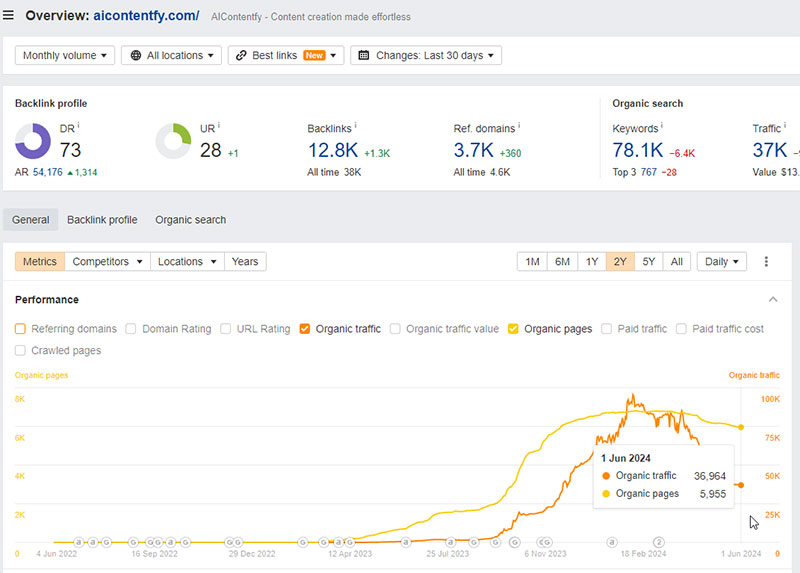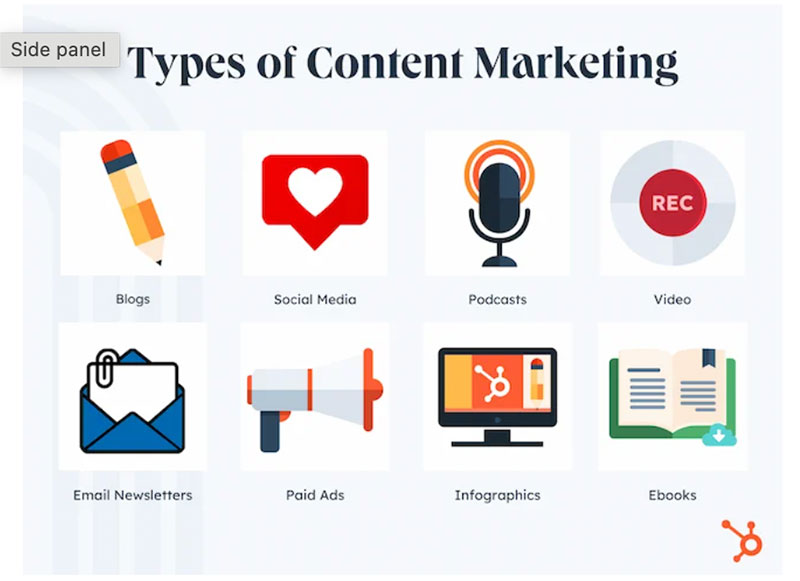Ever felt like your content marketing efforts are going in circles, yielding little to no results? You’re not alone.
Navigating the labyrinth of content marketing is complex, with a minefield of potential pitfalls. From optimization errors to misguided campaigns, the path is fraught with challenges.
Understanding content marketing mistakes is crucial for crafting a strategy that not only engages but converts.
Picture this: you’ve poured hours into a campaign only to see a conversion rate drop significantly. Annoying, right? Well, that’s just the tip of the iceberg.
In this article, we’ll dive deep into the common mistakes that plague content marketers, issues from inconsistent messaging to outreach blunders.
By the end, you’ll be equipped with the knowledge to fine-tune your approach, identify areas for improvement, and steer clear of these costly errors. Stick around, and let’s navigate these treacherous waters together.
Content Marketing Mistakes
| Mistake | Description | Potential Impact | Suggestion for Avoiding |
|---|---|---|---|
| Lack of Clear Strategy | Not having a defined content marketing strategy | Inconsistent messaging, poor ROI | Develop a documented content strategy |
| Ignoring Audience Needs | Creating content without understanding audience needs | Low engagement, high bounce rate | Conduct audience research, create personas |
| Poor Quality Content | Producing low-quality or irrelevant content | Damage to brand reputation | Focus on quality over quantity, use professional writers/editors |
| Inconsistent Posting Schedule | Posting irregularly without a consistent schedule | Loss of audience interest | Create a content calendar, schedule posts in advance |
| Not Measuring Results | Failing to track content performance metrics | Missed opportunities for improvement | Use analytics tools, set KPIs and track them regularly |
| Overlooking SEO | Not optimizing content for search engines | Low organic traffic | Implement SEO best practices, use keyword research |
| Neglecting Mobile Optimization | Ignoring mobile users in content design and formatting | Poor user experience on mobile | Ensure content is mobile-friendly, responsive design |
| Not Promoting Content | Only publishing content without promoting it | Limited reach and visibility | Use social media, email marketing, and other channels to promote content |
| Failing to Update Content | Letting content become outdated and irrelevant | Decreased relevance and authority | Regularly update and refresh existing content |
| Ignoring Feedback | Not taking audience feedback into account | Missed opportunities for improvement | Actively seek and incorporate feedback, engage with your audience |
Developing a Content Strategy
Importance of a Documented Content Strategy
Creating content without a solid plan is like setting sail without a map; you’re bound to get lost.
A well-documented content strategy is the cornerstone of effective marketing.
Aligning content with business goals
Why produce content if it doesn’t serve your overarching business mission? Every blog post, social media snippet, and multimedia piece should tie back to measurable business goals.
Want to boost brand awareness? Improve lead generation? Drive sales? It’s all about ensuring that content is pinpointed to hit those targets.
This alignment guarantees that your efforts are not just noise but a cohesive, purposeful campaign.
Creating a master plan
A master plan is more than a calendar; it’s a road map that outlines every step your content will take. Think of it as the skeleton, providing structure to your creative body of work.
Identify key themes, formats, and schedules in advance. Use tools like HubSpot or a Content Management System (CMS) to automate and streamline these processes.
Comprehensive planning eliminates ad-hoc chaos, ensuring that every piece of content fits into the larger puzzle.
Understanding Your Audience
The linchpin of any successful content strategy is a deep, nuanced understanding of your audience.
Without this, you’re shooting in the dark.
Creating accurate buyer personas
Who are you talking to? If you don’t know, you can’t tailor your message effectively. Develop detailed buyer personas to crystallize your understanding.
Age, job title, interests, challenges—these are some of the vital elements that go into creating a persona. Include data from Google Analytics or BuzzSumo to inform this.
Accurate personas help ensure that your content speaks directly to the needs and desires of your audience.
Conducting audience research
Research isn’t a one-time affair; it’s an ongoing process. Surveys, social media polls, and analytics tools like SEMrush and Ahrefs can provide valuable insights into what your audience is searching for and engaging with.
Audience research should form the backbone of your content strategy, dictating not just what you create but how you distribute and promote it. Analyze data trends and adapt.
The market evolves, and so should your strategy.
Content Creation
Quality vs. Quantity
Alright, let’s dive into the eternal debate.
Importance of high-quality content
High-quality content isn’t just a luxury; it’s the lifeblood of effective marketing.
Think about it—would you rather read a meticulously crafted blog post with valuable insights or skim through a dozen fluff pieces?
Quality captures attention, fosters trust, and propels engagement. This isn’t limited to written words; visuals, voice, and video quality matter too.
Pitfalls of focusing solely on quantity
Churning out mountains of content might seem like a winning strategy. More content equals more chances to rank, right?
Wrong.

This leads to one of the biggest content marketing mistakes—sacrificing depth for breadth.
When you focus solely on quantity, the end result is often shallow and generic, failing to resonate with your audience.
Trust me, a thousand lackluster posts won’t make up for a single powerful article that hits home.
Diverse Content Types

Gone are the days of the one-trick pony blog.
Beyond blog posts
The world doesn’t revolve around blog posts alone. In an era dominated by multimedia, you need to diversify.
Think infographics, podcasts, webinars, eBooks—the list is endless.
This isn’t just about variety; it’s about delivering your message through the medium your audience prefers.
When you use diverse formats, you cater to different preferences and learning styles, creating a richer experience.
Incorporating multimedia content
Multimedia content isn’t just eye candy; it’s a game-changer. People engage longer with videos, share infographics more, and remember auditory content better.
Look at platforms like YouTube and Instagram—audiences are hungry for more than just text.
Integrate videos, audio clips, and interactive elements to make your content more engaging and dynamic. A well-executed mix of formats can boost dwell time, improve user experience, and drive better results.
Balancing SEO and Content Quality
SEO is your best friend, but only if you handle it with care.
Integrating SEO without compromising quality
Yes, keywords matter. But shoehorning them into your content is a no-go. Context and natural flow should reign supreme.
RankBrain and other advanced algorithms can tell when content is richly informative versus when it’s keyword-stuffed drivel.
Skillfully integrate keywords, but prioritize readability and value. The goal is not to impress a robot but to provide genuine value to a human reader.
Avoiding over-optimization
SEO is a powerful tool, but overdoing it can backfire.
Over-optimization, like keyword stuffing and overly aggressive link-building, can turn your content into a nonsensical mess. Google’s wise to these tricks and penalizes accordingly.
Strike a balance—use tools like Yoast SEO or Google Search Console to fine-tune without overloading. Create content that’s both search engine-friendly and reader-centric.
Content Distribution and Promotion
Strategic Distribution Channels
Creating stellar content? Great. But if no one sees it, does it even matter?
Identifying and leveraging the right channels
Not all platforms are created equal.
Facebook, LinkedIn, Instagram, TikTok—each one has its own unique audience and engagement style.
The first step? Identify where your audience hangs out the most. Use tools like Google Analytics to see which channels drive the most traffic to your site.
Quora and Reddit might surprise you as untapped goldmines. Leverage these channels by posting tailored content that fits the platform’s vibe.
Think visuals for Instagram, professional insights on LinkedIn, and trending memes on Twitter.
Importance of content promotion
Promoting it ensures your efforts don’t gather digital dust.
Paid advertising like Google Ads or using social media boosting features can give your content the push it needs.
Don’t forget email marketing—tools like HubSpot make segmentation and personalization a breeze.
Cross-promote across your channels and collaborate with influencers. Content that’s promoted well gets shared, and shared content gains visibility.
Consistent Publishing Schedule
One of the more understated aspects of content marketing, yet crucial.
Establishing and maintaining consistency
Consistency isn’t just a best practice; it’s a necessity.
Whether you’re posting daily, weekly, or even monthly, sticking to a schedule helps build trust with your audience.
Use a content calendar, like the one in SEMrush, to plan your posts in advance.
This not only keeps you on track but also ensures you can strategically release content during peak times.
Avoiding the pitfalls of inconsistency
The downside? Inconsistency breeds disinterest.
If you go AWOL for weeks, don’t be surprised if your engagement metrics plummet. It’s one of those content marketing mistakes that’s surprisingly easy to make.
Keep an eye on your analytics using tools like Google Search Console to identify when you’re losing traction.
If you spot a dip, it might be time to reassess your schedule or content quality.
Measuring and Analyzing Performance
Importance of Data and Analytics
So, you’ve hit publish. Now what? Ignoring analytics is like shooting in the dark.
Tracking key metrics
Metrics are your compass. Without them, you’re lost at sea.
Traffic? Essential.
Engagement? Crucial.
Conversion? Vital.
Use Google Analytics to track these metrics, ensuring you have a clear picture of what’s working and what’s not.
Dive into numbers like bounce rate, average session duration, and source/medium reports.

Don’t just look at vanity metrics—likes and shares are great, but if they’re not driving action, they’re not moving the needle.
Using data to inform strategy
Data tells a story. The trick is knowing how to read it.
Tools like SEMrush and Ahrefs provide insights that can refine your strategy. Notice a drop in organic traffic? Maybe it’s time to revisit your SEO.
See that a particular blog post is blowing up? Consider creating more content along those lines.
Split-test different versions of your content and tweak based on performance. It’s a continuous loop of creation, analysis, and optimization.
Updating and Repurposing Content
Old content doesn’t have to stay old.
Keeping content current

Stale content isn’t doing you any favors. Updating older posts can breathe new life into them. Refresh outdated statistics, add new insights, and optimize for current SEO guidelines.
This not only improves the content but can also elevate its ranking in search engines.
Use tools like BuzzSumo to find trending topics related to your existing posts and incorporate those elements.
Benefits of repurposing existing content
Why create from scratch when you can repurpose? Transforming a well-performing blog post into an infographic or a video can reach different segments of your audience.
HubSpot’s repurposing strategies are a great resource here.
Turn your data-heavy post into a webinar, create a podcast from your interviews, or spin off a series of social media posts. Each new format offers a fresh angle and additional reach.
Common Pitfalls and How to Avoid Them
Lack of Audience Understanding
Stumbling around in the dark isn’t a strategy. It’s a recipe for failure.
Consequences of not knowing your audience
You launch a campaign, but…crickets. Why? Because you didn’t dig deep enough into who you’re speaking to. No buyer personas, no audience research, just a hope and a prayer.
Missing the mark means wasted resources, zero engagement, and a tarnished brand image.
Think of it as shouting into the void—the wrong message to the wrong people.
Strategies to improve audience insights
Time to play detective. Dive into Google Analytics, survey your current customers, and analyze social media interactions.
Tools like HubSpot can help you create detailed buyer personas.
Dig into your Facebook Insights and Instagram Analytics to understand what really clicks.
Use SEMrush to see what keywords your audience is searching for. Know their pain points, interests, and habits. Use that intel to craft content that speaks directly to them.
Unrealistic Expectations
The fast lane looks tempting but often leads to dead ends.
Understanding content marketing timelines
Rome wasn’t built in a day, and neither is a successful content strategy. Content Marketing mistakes often stem from expecting overnight success.
Understand that it takes time to build authority, engage audiences, and see tangible results.
Be patient. Each blog post, social media update, and email connects a dot on a much larger canvas.
Managing expectations for instant results
Set realistic milestones. Communicate with stakeholders that patience is part of the plan.
Track progress but resist the urge to pivot constantly in search of quick wins.
Use tools like Google Search Console to track gradual improvements.
Building a robust strategy is a marathon, not a sprint. Focus on sustained growth and consistent engagement.
Overemphasis on Best Practices
Best practices are great guidelines, but they’re not gospel.
Flexibility and adaptation
Rigidity can be your downfall. Best practices provide a framework, but don’t let them stifle your creativity or adaptation. Algorithms change, markets shift, audiences evolve.
Be flexible. Maybe it’s time to repurpose an old blog post into an interactive video or use techniques from influencer marketing.
Dive into Keyword Planner to find emerging trends and adjust your content accordingly.
Balancing best practices with innovation
Innovation trumps imitation. Sure, follow SEO guidelines and use structured data like schema markup, but don’t be afraid to break the mold.
Moz and Ahrefs offer invaluable insights, but always add your twist. Your unique approach can set you apart in a sea of sameness. Brands that push boundaries win.
Experiment, measure the results, and refine your strategy. The balance between best practices and innovation sparks success.
FAQ On Content Marketing Mistakes
What are the biggest content strategy errors?
Failing to research your target audience tops the list. Without knowing who you’re speaking to, your content will miss the mark.
Also, neglecting SEO integration is a major blunder. Your keywords and LSI keywords must align with user intent to avoid dropping off the search radar entirely.
How can SEO blunders affect content marketing?
Ignoring SEO metrics can render even high-quality content invisible. Misusing meta tags or overlooking backlinks reduces visibility.
Additionally, not including alt tags and neglecting internal links can severely hamper your page’s performance. These mistakes ensure your content gets lost in the vast digital ocean.
Why do conversion rates drop suddenly?
A sudden drop typically points to outdated content, ineffective call-to-actions, or changes in audience behavior.
Misaligned business goals or inconsistent messaging can also alienate your audience. Regularly analyzing analytics is essential to identify and rectify these issues promptly.
What are common outreach blunders?
Reaching out without proper research is the biggest error. Sending generic emails or misaligning your pitch with potential collaborators’ interests can taint your brand.
Using a poor headline or failing to articulate a clear value proposition often results in ignored emails and lost opportunities.
How does poor user feedback management impact strategy?
Ignoring user feedback is akin to throwing away gold. Feedback highlights what’s working and what’s not.
It can guide the improvement of your content types, conversion rates, and overall strategy. Regularly updating your content based on actual user input is crucial.
Why is mobile optimization crucial?
Most users consume content on mobile devices. Ignoring mobile optimization leads to a frustrating user experience, which increases your bounce rate and diminishes engagement.
Ensuring your site is mobile-friendly captures a broader audience and ensures you don’t lose potential consumers.
How do outdated content and quality misconceptions affect your reach?
Outdated content erodes credibility and utility. Believing that “quality over quantity” alone matters is a misconception.
Both elements are essential. Regularly updating your content and maintaining a balance of quality and quantity keeps your audience engaged and ensures relevance.
What are the repercussions of not understanding your audience?
Understanding your audience ensures your content resonates and converts. A mismatch can lead to poor engagement and higher bounce rates. Keyword errors and irrelevant themes can further tarnish your efforts, making it essential to align content with audience expectations and preferences.
How crucial is competitor analysis in avoiding content mistakes?
Competitor analysis provides invaluable insights into successful strategies and pitfalls. Overlooking this analysis puts you at a serious disadvantage.
Understanding competitors’ keywords, SEO metrics, and popular content types helps refine your approach and avoid making the same mistakes.
Why is it important to monitor and adapt content strategies?
Constantly evolving user behaviors and SEO algorithms make it essential to monitor and adapt.
Regularly revising meta tags, updating content, and aligning with current business goals ensures sustained relevance. Without adaptation, even the best strategies become stale and ineffective.
Conclusion
Content Marketing mistakes can derail the most well-intentioned efforts. From optimization errors to misguided campaigns, each misstep presents an opportunity to learn and refine your strategy.
Ignoring SEO integration and relying on outdated content are common pitfalls. Effective keyword usage and consistent content updates are paramount. User feedback and competitor analysis aren’t just supplementary—they’re vital.
Your conversion rates suffer when CTAs are unclear and headlines lack impact. Targeted audience research eliminates guesswork, ensuring your content aligns and resonates.
Outreach blunders, inconsistent messaging, and lack of mobile optimization further weaken your strategy. Every missed optimization is a potential audience lost. Regular evaluation and adaptation of your approach safeguard against these costly errors.
Proactively addressing these mistakes transforms your strategy from aspirational to actionable, enabling sustained growth and visibility. The key lies in perpetual learning and iteration.
If you liked this article about content marketing mistakes, you should check out this article about the benefits of content marketing.
There are also similar articles discussing developing a content marketing strategy, content marketing goals, content marketing personas, and content audit.
And let’s not forget about articles on content audit checklist, how to conduct a content audit, how to create a content plan, and content marketing KPIs.





